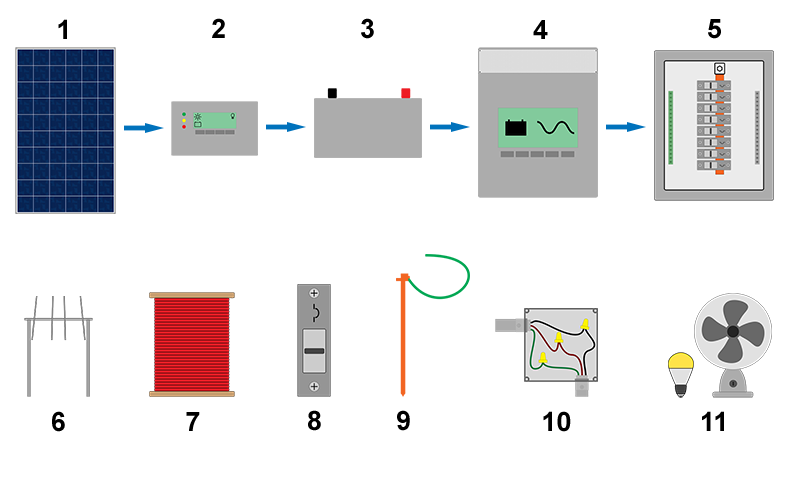Basic stand-alone PV system components
Stand-alone PV systems, regardless of where one is at in the world, share the same basic components. This article will give a high-level overview with links to more detailed information on each component. To understand how power flows between key components see Power flow between components.
Contents
PV source
A photovoltaic (PV) system has a PV source - one or more solar PV modules - that converts the energy of the sun into electrical current. PV modules use the photovoltaic (PV) effect to generate electrical current upon exposure to light. If there are multiple modules in the system, they are typically mounted together and connected into an array.
Energy storage
A stand-alone PV system requires some type of energy storage system in order to provide energy at night or during periods of bad weather. The most common form of energy storage for stand-alone PV systems is batteries. There are many different kinds of batteries that each carries advantages and disadvantages. If there are multiple batteries in a system, they are arranged together into what is referred to as a battery bank.
Charge controller
A charge controller or inverter-charger is essential as batteries have specific charging requirements and proper charging is essential to ensuring that they have a long life. A system may have multiple parallel solar charge controllers and incorporate other power sources.
Inverter
In order to power alternating current loads, it is necessary to have an inverter in a stand-alone system. The battery bank provides a stable voltage and current to the inverter, which it can then convert into stable alternating current to supply AC loads.
Power distribution
A stand-alone PV system requires some way to safely distribute power to loads such as a distribution panel or busbars.
Mounting system
PV modules must be anchored to some type of mounting system to ensure that their production is maximized with the correct orientation and angle relative to the sun, but also to ensure that they are not damaged by weather.
Conductors
All of the different electrical components of a system are connected together with conductors - wire and cable - that must be appropriate for the voltage, current and conditions to which they will be subjected.
Overcurrent protection/disconnects
All equipment in a PV system - conductors and all components - have a maximum amount of current that they can handle and should therefore be protected from currents that could exceed their maximum rated current. Otherwise, an electrical fire can result. Devices that protect equipment from excess current are called overcurrent protection devices (OCPDs), the most common of which are breakers and fuses. Additionally, in any system it is necessary to isolate all components of a PV system from all potential power sources in order to be able to work safely for maintenance or troubleshooting. Both of these functions can be often be performed by an overcurrent protection device, but a seperate means of disconnection may be necessary in some cases.
Grounding system
A properly built grounding system ensures safety for users and protections the system equipment against damage from lightning. Small PV systems often do not incorporate a grounding system due to cost, but the benefit of proper grounding increases as system size and cost increases.
Physical conductor protection
If a conductor could potentially be damaged by the conditions in which it is installed, weather, rodents, building occupants or any other source, it is necessary to provide physical wire protection using conduit and junction boxes.
Loads
The purpose of an off-grid PV system is to be able to provide power for loads. The term "load" covers anything that consumes energy like appliances and lighting. There are important considerations that go into choosing lighting and appliances for use with an off-grid system. It is important to try to consider ways to reduce energy consumption before beginning to design a PV system.
